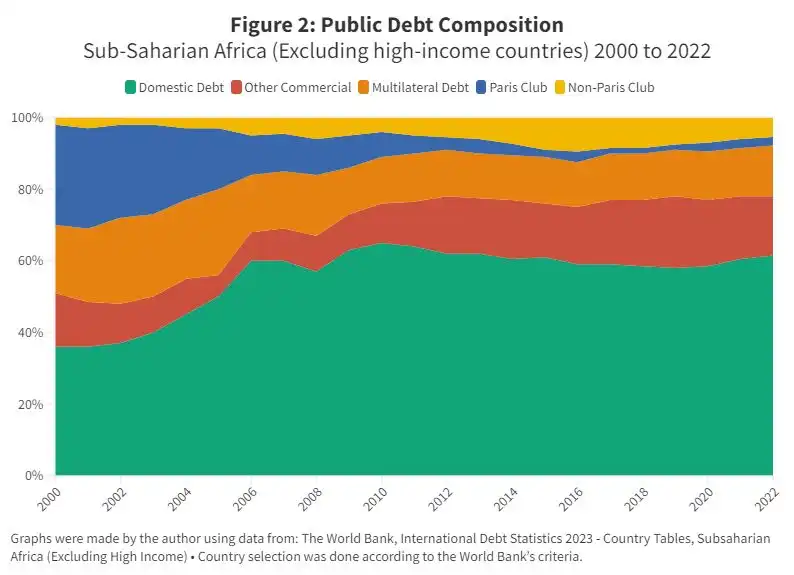Home>The changing dynamics of global debt

11.09.2024
The changing dynamics of global debt
Jean-Pierre Landau is Affiliated Professor at the Department of Economics of Sciences Po.
This commentary presents a snapshot of the global sovereign debt and international finance landscape.
Four major trends emerge in the current environment
1. The level of public debt is unprecedented in peace time
In advanced (OECD) economies, the debt to GDP ratio is about 83% – 122.1% for the United States (US) and 83.3% in the European Union (EU)(1). In emerging countries, the ratio was 68%(2). Notably, in Sub Saharan Africa, sovereign debt is back to its 2000 levels, before the Heavily Indebted Poor Countries (HIPC) initiative led to a general official debt cancellation in low-income countries.

How will debt market react to this unprecedented level of debt is hard to predict. Possible consequences include changes in investors’ approach to risk, higher volatility in sovereign yields, increased differentiation in interest rates among borrowers, and higher borrowing costs for those with low credit ratings. In addition, it will become more difficult to mobilize concessional finance and public transfers from advanced economies to low-income countries. The former are also experiencing high level of debt and budget constraints.
2. No short-term improvement can be expected
Some relief may come from lower nominal long-term rates as inflation pressures abate, risk premia soften, and monetary policies normalize around the world. This will reduce the probability of rollover crises and put some debt back on a path of sustainability.
However, as pointed in the latest OECD Global Debt Report, primary deficits are projected to persist, or even increase in many advanced economies in the near future and so debt to GDP ratios will keep growing.
3. The international financial system has become more resilient
During previous episodes of rising US and global interest rates (the most notable being the “taper tantrum” in June 2013), emerging economies experienced strong capital outflows, pressures on their exchange rates and, in some cases, surges in debt distress and defaults.
The current cycle has been different. Of the multiple shocks that occurred in 2021, 23 have been well absorbed through a mix of tighter monetary policy, exchange rate depreciation and fiscal consolidation. This performance has been made possible by the deployment of local currency debt markets, increased fiscal and monetary credibility, strong buffers in foreign exchange reserves as well as ample support from the International Monetary Fund (IMF) and the World Bank. Debt defaults have been limited in numbers and mainly circumscribed to low-income countries.
4. The debt restructuring process is badly damaged
The current political and financial environment is not conducive to effective and sustainable solutions to debt distress. This is due to the fragmentation in the group of creditors and the existence of two different but equally difficult class of creditors: international bond holders and China.
The former have replaced banks as the main private market creditors. They have no direct relationship with the debtors, no incentive to compromise, no pressure to coordinate. They are permanently tempted to embrace free riding and so-called holdout strategies, even if the generalization of Collective Action Clauses has made such tactics risker and more costly.
As for China, it has become the dominant lender in most low-income countries, especially those in sub-Saharan Africa. China is not a member of the Paris Club where bilateral public creditors have coordinated their actions for more than five decades. China has developed its own approach to debt restructuring based mainly on private bilateral rescheduling and liquidity swaps concluded in renminbi with the debtors’ central banks.

To address these issues, in 2020 the G20 created the Common Framework for Debt Treatments beyond the Debt Service Suspension Initiative (DSSI). It is co-chaired by France and China. The Common Framework’s informal setting makes it difficult to implement the basic principles of multilateral debt restructuring, i.e. transparency and comparability of treatment. As a result, agreements have been slow to reach as in the case of Zambia, Sri Lanka and Ghana. Multilateral institutions such as the IMF are actively involved in the Common Framework.
Four major issues for the future
Beyond existing debt, the key problem over the medium term is financing the development of emerging and frontier economies. These countries are facing three challenges: 1. to further reduce poverty; 2. to finance and manage the climate and energy transition; 3. to accumulate a productive capital stock that for Sub Sahara Africa needs to be commensurate to the region’s fast-growing population.
Domestic resources can be mobilized, but most countries will need significant net capital inflows. This leads to the following issues.
1. The global savings – investment balance and the equilibrium interest rate
Financial transfers and, on the long run, debt sustainability will depend on global growth, saving/investment balances and the so-called neutral equilibrium interest rate. In the last three decades long term interest rates have been historically low, and this has contributed significantly to debt sustainability. The future, however, looks more uncertain as two factors might push global interest rates higher: 1. ageing and the consequent demographic transition that will reduce global savings; 2. massive investments required for climate change mitigation and the energy transition.
2. The resilience of “core” bond markets
Episodes of major liquidity dearth have occurred in developed sovereign bond markets since 2019, the most significant being the “Dash for Cash” in March 2020 in the aftermath of the outburst of the Covid-19 pandemic. These episodes could only be dealt with through massive interventions by the major central banks. Even if they are due to exceptional circumstances, they reveal some fragility in the world’s most developed and low-risk bond markets and their dependence on central banks to provide liquidity for their functioning and equilibrium.
3. The capacity of capital markets to allocate proper funding to low-income and Sub-Saharan African countries
Official flows will remain critical but hindered by budget constraints in advanced economies. Emerging and low-income countries, therefore, will be increasingly dependent on private capital flows. But these flows are volatile, correlated with global financial conditions, sensitive to political risks and poor governance, and so prefer not to invest in low-income economies.
Specific instruments can help reduce the perceived risk for investors. Here, multilateral Development Banks (MDBs) can play a crucial role, by developing guarantees and combining public and private funds, a practice known as blending, For recipient countries, a proper legal framework and the implementation of policy reforms can create a more favorable investment environment.
4. The future of concessional finance
Concessional finance is made of grants and loans with interest rates lower than the commercial ones and can be provided by bilateral or multilateral donors. There is an important, although quiet, debate on how to allocate concessional funds in the future. The current dominant approach is that concessional finance must be re-directed to climate and energy transition for adaptation and mitigation purposes (through blending). Accordingly, concessional finance should be directed to low- and middle-income countries. Another approach reckons that concessional finance should only focus on low-income countries and human development objectives (education health, child mortality, pandemics, humanitarian actions) including climate adaptation.
Notes
- 1.Figure 1: Historical evolution of the Debt-to-GDP ratio in developed and emerging countries*. Source: Data from 1830 to 2015 was retrieved from the Historical Public Debt Database by the International Monetary Fund (2023). Data from 2015 to 2029** was retrieved from the World Economic Outlook Database by the International Monetary Fund (April 2024). Graph made by Ana de la Fuente Gil. * For simplification purposes, only G20 countries were examined. Australia, Canada, France, Germany, Italy, Japan, South Korea, the United Kingdom, and the United States were considered Developed countries. Argentina, Brazil, China, India, Indonesia, Russia, Saudi Arabia, South Africa, and Turkey were considered emerging countries. ** Estimations start after 2023
- 2.Figure 2: Debt Composition of Sub-Saharian Africa* 2000-2022 Source: Data was retrieved from the International Debt Statistics database by the World Bank (2023). Graph made by Ana de la Fuente Gil. *Country selection was done according to the World Bank’s criteria.
(credits: Vintage Tone/Shutterstock )
Contact
General Inquiries: sovdebtchair.info@sciencespo.fr